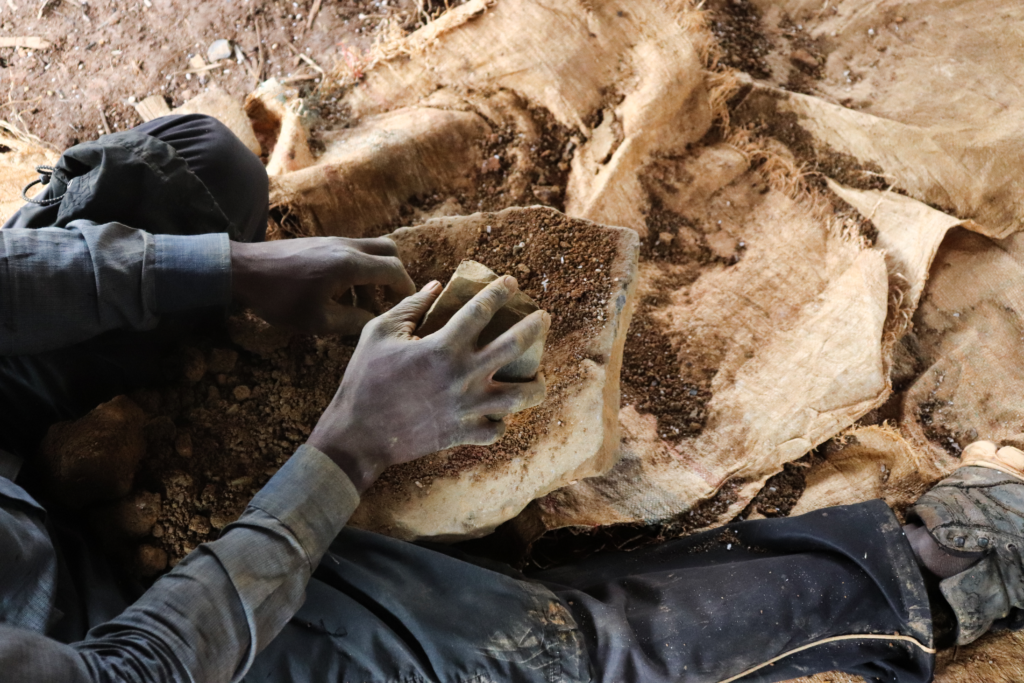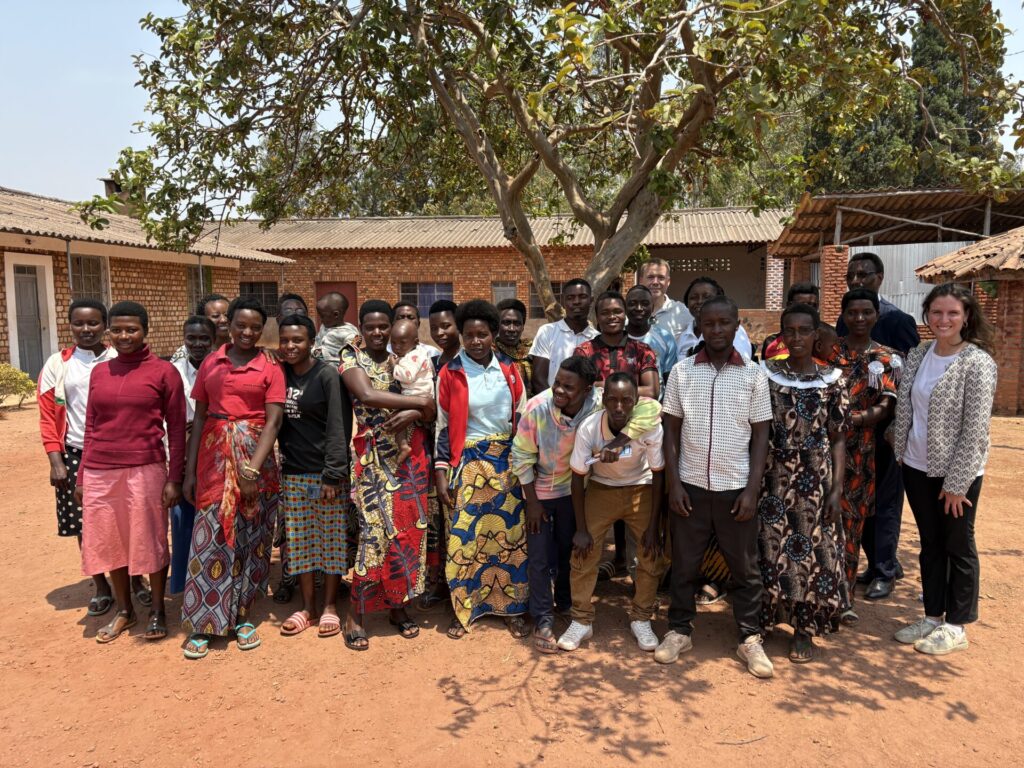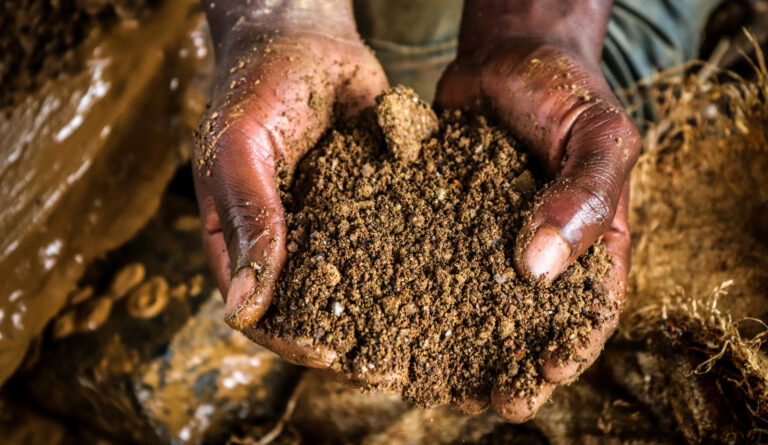
Started in 2012, the revision of the Congolese mining code resulted in the promulgation of a new text in March 2018. Supposed to increase public revenue to contribute to the development of the country, this legislative reform was not unanimous. On the contrary, although it was welcomed positively by civil society, it was strongly contested by mining companies. But what changes does this new mining code contain? And who will it really benefit?
The Democratic Republic of Congo (DR Congo) is an immense country (the second largest in Africa) with rich and varied natural resources. In addition to impressive fauna and flora, one of the largest areas of equatorial forest in the world and significant oil reserves, the subsoil of DR Congo is full of minerals and metals. For example, the country has more than half of the world's reserves of cobalt, a rare and extremely coveted mineral because it is essential for the manufacture of many high-tech objects and for what is called the energy transition. [1]Electric cars, for example, are very fond of cobalt. On the issues linked to electric cars, see: Justice and Peace, Car of the future or future without a car?, September 25, 2018. … Continue reading. Despite this, the country remains one of the poorest in the world and with one of the lowest human development indicators (with an index of 0.457 the country was 176th out of 189 in 2018). [2]UNDP, Human Development Indices and Indicators, 2018 Statistical Update.). Informality, opacity and poor governance of the mining sector, illegal exports and even tax evasion, combined with the fact that the old mining code was very liberal, are some elements which explain why natural resources do not benefit until now very little to the Congolese population and the development of the country.
The old mining code, written by experts from the World Bank, was adopted in 2002, shortly after Joseph Kabila came to power. By weakening several existing regulations, including on taxes, it was considered by civil society, and even by the International Monetary Fund (IMF) [3]International Monetary Fund: The Democratic Republic of Congo excels in growth, but lags behind in poverty reduction, IMF Bulletin, … Continue reading, as extremely favorable to foreign investors. It has thus made it possible to attract numerous companies to the territory: increasing from 35 mining companies in 2002 to 482 companies holding mining and quarrying rights at the end of 2016. [4]Raf Custers, Congo: multinationals tirelessly in opposition, March 2019.. This mining code also allowed Joseph Kabila to build, from the start of his mandate, very close relationships with multinationals. [5]According to the results of an investigation by the Bloomberg agency published at the end of 2016, Joseph Kabila and his family would have constituted a gigantic network of companies which would have brought in… Continue reading. It was, so to speak, a win-win deal, economically and politically, for businesses and those in power.
However, it was less so for the interests of the State and the Congolese population who, in the end, benefited very little from the benefits of mining. According to Albert Yuma, director of Gécamines, the mining company owned by the Congolese state, since the implementation of the mining code in 2002, the various partners of Gécamines have exported more than 48 billion US dollars while the Congolese state received less than $3 billion [6]Marie-France Cros, DRC: Albert Yuma will unilaterally review mining partnerships, La Libre Afrique, November 21, 2017..
However, according to the British NGO Global Witness, one of the major culprits for this shortfall is none other than Gécamines, which receives more than a hundred million dollars per year from private companies, but only pays back a tiny part in the state coffers. For example, between 2013 and 2015, no less than 1.3 billion dollars would have escaped state organizations. Sums – and not the least – which should have been used to finance essential public services for the Congolese population.
Since the mining code cannot be modified for ten years, the Congolese government had to wait until 2012 to be able to launch a revision process. This of course did not please companies who saw their economic interests threatened. Arguing that the fall in metal prices threatened their activities, the mining companies, from the start of the process, tried to convince the government to abandon this revision project. They even threatened to defend their investments by all national and international means at their disposal, including through international arbitration . After a two-year suspension, the negotiations, in which representatives of the government, the private sector and civil society participated, resulted in the adoption of a new text. Ultimately much stricter than expected. In response, the seven largest foreign companies present in the country [7]Randgold Resources (South African company), CMOC International (Chinese), Glencore (Anglo-Swiss), Anglo Gold Ashanti (South African), Ivanhoe Mines (Canadian), Zijin Mining Group (Chinese)… Continue reading did not wait long to slam the door of the Fédération des Entreprises du Congo (FEC), accused of not having sufficiently defended their interests. On the other hand, they recalled their readiness to begin negotiations with a view to finding common ground, as had been promised by former President Joseph Kabila. In any case, in the law at least, no concessions have been made to the mining companies.
The new code contains 32 innovations [8]They are all listed in the preamble to the new mining code.. The most contested by businesses are of course those relating to taxes. Mining royalties owed by companies thus increase from 2% to 3.5% of the gross commercial value for base metals [9]Base metals are those that oxidize, tarnish, or corrode easily when exposed to air or moisture. Due to their natural abundance in the crust... Continue reading (such as copper, tin, aluminum, nickel, zinc and lead) and/or non-ferrous[10]These are base metals to which certain rare and semi-precious metals such as titanium, cobalt, vanadium and molybdenum can be added. These metals are part of the composition… Continue reading as well as for precious metals. As for the famous “strategic substances [11]Defined by the new mining code as any mineral substance which, according to the current international economic situation and the government's assessment, is of interest... Continue reading ", that is to say cobalt, germamium and coltan [12]Decree No. 18/42 of November 24, 2018 declaring cobalt, germamium and columbo-tantalite “coltan” as strategic mineral substances., their fee increases from 2 to 10% from the promulgation of the new code. Furthermore, a new “special tax on excess profits” of 50% is planned when the prices of materials or commodities experience an exceptional increase, greater than 25% compared to those included in the bankable feasibility study of the project [13]Article 251 bis.. Given the ever-increasing demand for cobalt [14]Between 2012 and 2017, global demand for cobalt increased by 30% and is expected to almost double by 2026. and the recent explosion in its price [15]The price of cobalt experienced a boom in March last year, an increase of 190% in just over a year. Since then the price of cobalt has collapsed by more than 60%., we easily understand that this five-fold increase makes businesses cringe. Especially since the period of stability, which guaranteed a fixed tax and customs regime of ten years, was lowered to five years.
According to Natural Resource Governance Institute, the application of the new code could increase the average effective tax rate from 48 to 72% on a copper/cobalt mine, and from 55 to 95% on a gold mine Thomas Lassourd, The taxation of the new mining code of the Democratic Republic of Congo, Natural Resource Governance Institute, Analysis, November 2018.. But it is still necessary to control and actually collect the tax. Not only was this a major problem under the 2002 mining code, but companies now have even more reasons to use financial arrangements to try to replace their tax obligations. Especially since article 220 provides that the Prime Minister can grant “incentive measures” to favor certain mining projects. This opens the door to even more corporate lobbying for preferential treatment. The discretion to grant such measures left to the Prime Minister also increases the risks of corruption. A significant point when we know that the DR Congo is one of the most corrupt countries in the world, ranked 161st out of 180 by the NGO Transparency International [16]Transparency International, Corruption Perceptions Index 2018..
In addition to these tax increases, the code provides for greater “control” by the Congolese state over the sector through:
- the increase in the share of the State's participation in the company's share capital (from 5 to 10%);
- the exclusivity of subcontracting only to companies whose majority of capital is owned by Congolese;
- the required participation of at least 10% of individuals of Congolese nationality when creating a mining company;
- the participation of Congolese in the capital of counters for the purchase and sale of precious materials and processing;
- the effectiveness and control of the repatriation of 60% or 100% of export sales revenue.
In addition to its increase, the new mining code provides for a new distribution of mining royalties. It is in fact planned that 50% of the royalty will go to the central government, 25% to the provincial administration, 15% to the decentralized territorial entity (ETD) where the exploitation takes place and 10% to a mining fund for future generations [17]Article 242 of the new mining code.. Previously, the company paid the fee directly to the central government which then had to pay a share to the decentralized entities. But, in reality, this transfer was rarely carried out (today there are only 4-5 ETDs which receive the royalty), and when this was the case, it mainly benefited the chiefdoms which had, for example, purchased cars [18]Information obtained during a workshop on the mining code organized in Kinshasa from June 4 to 6, 2019 with CNCD-11.11.11 partners.. Theoretically, these new provisions should significantly increase administration budgets and contribute to local development. But it remains to be seen who will control where this money actually goes and what the ETDs do with it. As for the mining fund for future generations, no details are specified. A future decree from the Prime Minister is supposed to create and organize it. It is therefore still too early to evaluate it. Generally speaking, given the numerous risks that such a fund entails, particularly in terms of governance and management, solid support and the establishment of adequate institutional structures are essential.
In addition, the code provides for the obligation for the holder of mining exploitation rights to constitute an endowment of a minimum of 0.3% of their turnover which must contribute to community development projects. [19]Article 258 bis of the new mining code.. But for the moment, no company has declared these 0.3%. It will therefore also be necessary to provide a body for monitoring the effective payment of this grant.
On paper, the new code better protects local populations and the environment. For example, it replaces the environmental opinion with an environmental certificate as a condition for obtaining an operating permit. This must be issued by the Congolese Environment Agency and certify that the operating project complies with the principles of environmental and social safeguarding. Specifications, which define the socio-environmental obligations of mining operators towards local communities affected by mining activities, have also appeared [20]Article 285 septies of the new mining code.. It aims to serve as a framework agreement to “enable the realization of sustainable development actions in order to improve the economic, social and cultural well-being of local populations affected by mining activities”.
In addition, industrial responsibility is reinforced. Whereas before communities had to prove the existence of negative consequences of pollution, from now on, any holder of mining and/or quarry rights will automatically be considered responsible for damage caused to people, property and the environment, and this even in the absence of any fault or negligence. He will be required to repair them and can only be exonerated from his liability if he provides proof that this damage comes from a cause unrelated to his mining activity. [21]Article 285 bis of the new mining code.. This reversal of the burden of proof has the potential to significantly improve access to justice by communities suffering environmental damage. Finally, the code provides that in the event of displacement of populations, the mining operator is required to first provide compensation, compensation and resettlement of the populations concerned. [22]Article 281 addition of paragraphs 7 and 7 bis..
These are good elements for local communities and environmental protection. But for the moment no local community seems to have been consulted. Furthermore, it is not always clearly established who will be responsible for monitoring these rules. It is therefore essential to make local communities aware of their rights and to inform them of possible recourse to be able to demand respect for these standards.
And the artisanal diggers in all this?
The code limits artisanal exploitation to adults of Congolese nationality, members of a cooperative. [23]On issues related to cooperatives, see EurAc analysis, Accompanying measures to the EU Regulation on responsible sourcing of minerals, For strengthening … Continue reading approved by the Minister and holders of an artisanal miner's card. Exploitation can only be carried out within an artisanal exploitation zone (ZEA). According to the code, these are generally those where industrial or semi-industrial exploitation is not possible [24]Section 109.. Artisanal diggers are therefore a minority but not marginal: the sector remaining very informal, it is difficult to have exact figures, but it is estimated that there would be approximately two million artisanal diggers in DR Congo. The code implicitly prohibits the work of children and pregnant women. But no other protection for artisanal diggers is provided.
The new legislation contains good provisions which largely follow the recommendations of civil society. Now all that remains is to implement it. Some institutions, for example the one responsible for managing the fund for future generations, have yet to be created and become operational. Furthermore, although the mining code provides for a whole range of sanctions, including in the event of violation of human rights, fraud and pillaging of natural mining resources as well as obstruction of transparency and traceability, it is not not clearly established who will be responsible for observing them. The government must therefore provide the necessary means to implement the reform and the legal changes must also be transposed through an administrative reform. A huge amount of popularization work (for example through translation into the four national languages: Lingala, Kiswahili, Tshiluba and Kikongo) and capacity building for authorities and various stakeholders is also crucial to ensure its effective application.
While some believe that the new mining code will guarantee better public revenues for the State for the benefit of local populations, others are more skeptical about the positive developments announced. According to them, this will not prevent the conclusion of other opaque agreements. Remember that Joseph Kabila promised businesses the possibility of dialogue after the promulgation of the code with a view to finding common ground. The profits could therefore continue to benefit a restricted group of people and not the Congolese people who, however, according to the Congolese Constitution [25]According to article 58 of the Constitution of the Democratic Republic of Congo of February 18, 2006: “All Congolese have the right to enjoy national wealth. The State has the duty to… Continue reading, has the right to enjoy the resources of the country. For others, higher taxes could harm DR Congo's competitiveness for investments. However, given the wealth of certain mining assets and the constantly increasing needs of importing countries (particularly for cobalt), this seems unlikely. The proof is that since the promulgation of the code, there are still as many investors. On the other hand, this could harm the development of less attractive, medium-sized deposits (for example in the copper sector), and therefore ultimately the development of the mining sector.
At the same time, civil society, which contributed greatly to the process of revising the Code and the Mining Regulations, must continue to monitor developments and encourage the new government, once in place, to ensure the application of the new provisions of the code. It is also fundamental that complaints and sanctions are applied in the event of non-compliance by companies. To do this, diggers and local communities must be made aware of the provisions of the new code, their rights and possible recourse. Civil society organizations working towards this, through awareness-raising work [26]Several Congolese civil society organizations have, for example, with the support of GIZ, developed in November 2018 a Popularization Guide to Law No. 18/001 of March 9, 2018 amending … Continue reading , training and advocacy, must be supported, both by the Congolese government and the international community which, through its supply, also has a responsibility and a role to play in the mining sector.
With this new mining code, the country is currently in a strong position vis-à-vis companies. It remains to be seen what the new President Félix Tshisekedi will do with what could be considered one of the last legacies of Joseph Kabila. For now, he says he wants to continue reforms initiated by his predecessor. Despite accusations of corruption, he, for example, reappointed Albert Yuma Mulimbi, close to former President Kabila and architect of the new mining code, at the head of Gécamines which he has led since 2010. So, rupture or continuity ? The future will tell.
Agatha Smyth.
Attachments
Notes[+]
| ↑1 | Electric cars, for example, are very fond of cobalt. On the issues linked to electric cars, see: Justice and Peace, Car of the future or future without a car?, September 25, 2018. On the issues linked to what we call rare earths, see: Justice and Peace, Rare earths… A more virtuous energy transition?, September 26, 2018, |
|---|---|
| ↑2 | UNDP, Human Development Indices and Indicators, 2018 Statistical Update. |
| ↑3 | International Monetary Fund : The Democratic Republic of Congo excels in growth, but lags behind in poverty reduction, IMF Bulletin, October 13, 2015. |
| ↑4 | Raf Custers, Congo: multinationals tirelessly in opposition, March 2019. |
| ↑5 | According to the results of an investigation by the Bloomberg agency published at the end of 2016, Joseph Kabila and his family would have constituted a gigantic network of businesses which would have brought in hundreds of millions of dollars. In the mining sector, they would control more than 120 gold, diamond, copper or cobalt extraction permits. |
| ↑6 | Marie-France Cros, DRC: Albert Yuma will unilaterally review mining partnerships, La Libre Afrique, November 21, 2017. |
| ↑7 | Randgold Resources (South African company), CMOC International (Chinese), Glencore (Anglo-Swiss), Anglo Gold Ashanti (South African), Ivanhoe Mines (Canadian), Zijin Mining Group (Chinese) and MMG (Chinese). These seven companies produce 85 % of copper, cobalt and gold from the Democratic Republic of Congo (DRC). |
| ↑8 | They are all listed in the preamble to the new mining code. |
| ↑9 | Base metals are those that oxidize, tarnish, or corrode easily when exposed to air or moisture. Due to their natural abundance in the earth's crust, their price is much lower than those of precious metals such as gold, rhodium, platinum, palladium and silver. |
| ↑10 | These are base metals to which certain rare and semi-precious metals such as titanium, cobalt, vanadium and molybdenum can be added. These metals are used in the composition of alloys containing very little or no iron. |
| ↑11 | Defined by the new mining code as any mineral substance which, according to the current international economic situation and the government's assessment, is of particular interest with regard to the critical nature and the geostrategic context. |
| ↑12 | Decree No. 18/42 of November 24, 2018 declaring cobalt, germamium and columbo-tantalite “coltan” as strategic mineral substances. |
| ↑13 | Article 251 bis. |
| ↑14 | Between 2012 and 2017, global demand for cobalt increased by 30% and is expected to almost double by 2026. |
| ↑15 | The price of cobalt experienced a boom in March last year, an increase of 190% in just over a year. Since then the price of cobalt has collapsed by more than 60%. |
| ↑16 | Transparency International, Corruption Perceptions Index 2018. |
| ↑17 | Article 242 of the new mining code. |
| ↑18 | Information obtained during a workshop on the mining code organized in Kinshasa from June 4 to 6, 2019 with CNCD-11.11.11 partners. |
| ↑19 | Article 258 bis of the new mining code. |
| ↑20 | Article 285 septies of the new mining code. |
| ↑21 | Article 285 bis of the new mining code. |
| ↑22 | Article 281 addition of paragraphs 7 and 7 bis. |
| ↑23 | On the problems linked to cooperatives, see the EurAc analysis, Accompanying measures to the EU Regulation on responsible mineral sourcing, To strengthen the governance of the artisanal mining sector in the DRC, March 2017, p.13-16. |
| ↑24 | Section 109. |
| ↑25 | According to article 58 of the Constitution of the Democratic Republic of Congo of February 18, 2006: “All Congolese have the right to enjoy national wealth. The State has the duty to redistribute them equitably and guarantee the right to development. ". |
| ↑26 | Several Congolese civil society organizations have, for example, with the support of GIZ, developed in November 2018 a popularization guide to law n°18/001 of March 9, 2018 amending and supplementing Law No. 007/2002 of July 11, 2002 on the Mining Code. |




